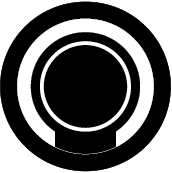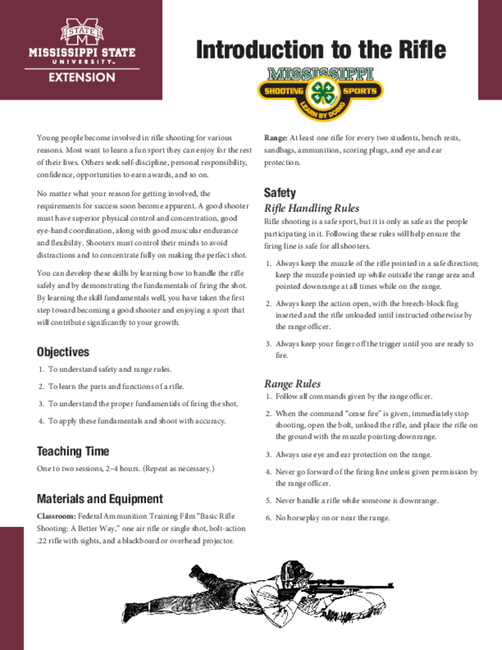Introduction to the Rifle
Young people become involved in rifle shooting for various reasons. Most want to learn a fun sport they can enjoy for the rest of their lives. Others seek self-discipline, personal responsibility, confidence, opportunities to earn awards, and so on.
No matter what your reason for getting involved, the requirements for success soon become apparent. A good shooter must have superior physical control and concentration, good eye-hand coordination, along with good muscular endurance and flexibility. Shooters must control their minds to avoid distractions and to concentrate fully on making the perfect shot.
You can develop these skills by learning how to handle the rifle safely and by demonstrating the fundamentals of firing the shot. By learning the skill fundamentals well, you have taken the first step toward becoming a good shooter and enjoying a sport that will contribute significantly to your growth.
Objectives
- To understand safety and range rules.
- To learn the parts and functions of a rifle.
- To understand the proper fundamentals of firing the shot.
- To apply these fundamentals and shoot with accuracy.
Teaching Time
One to two sessions, 2–4 hours. (Repeat as necessary.)
Materials and Equipment
Classroom: Federal Ammunition Training Film “Basic Rifle Shooting: A Better Way,” one air rifle or single shot, bolt-action .22 rifle with sights, and a blackboard or overhead projector.
Range: At least one rifle for every two students, bench rests, sandbags, ammunition, scoring plugs, and eye and ear protection.
Safety
Rifle Handling Rules
Rifle shooting is a safe sport, but it is only as safe as the people participating in it. Following these rules will help ensure the firing line is safe for all shooters.
- Always keep the muzzle of the rifle pointed in a safe direction; keep the muzzle pointed up while outside the range area and pointed downrange at all times while on the range.
- Always keep the action open, with the breech-block flag inserted and the rifle unloaded until instructed otherwise by the range officer.
- Always keep your finger off the trigger until you are ready to fire.
Range Rules
- Follow all commands given by the range officer.
- When the command “cease fire” is given, immediately stop shooting, open the bolt, unload the rifle, and place the rifle on the ground with the muzzle pointing downrange.
- Always use eye and ear protection on the range.
- Never go forward of the firing line unless given permission by the range officer.
- Never handle a rifle while someone is downrange.
- No horseplay on or near the range.
Know the Rifle and How It Works
Parts of the Rifle
- Stock
- Forearm
- Pistol grip
- Cheek piece
- Butt plate
- Action and bolt
- Trigger and trigger guard
- Safety
- Barrel
- Muzzle
- Front sight
- Rear sight
- Sling swivel
- Sling
Functions of the Rifle
- Loading
- Cocking
- Firing
Ammunition
- BB
- Air pellet: .177 caliber
- .22 long rifle
Firing the Shot
Determining Dominant Eye
Sighting with the dominant eye is a major advantage to the shooter; it decreases eye stress and fatigue and increases concentration and quickness. To find your dominant eye, follow these steps:
- With your arms extended, cup your hands to form a small hole.
- With both eyes open, locate a distant object through the hole formed by your hands.
- Slowly bring your hands to your face, keeping the object centered in the hole.
- The hole in your hands will come to your dominant eye.
The Aiming Process
- Proper use of the eyes
- Check for and correct any vision problems.
- Look straight forward out of the eye socket.
- Keep both eyes open—use blinders if needed.
- Do not aim for more than 8–10 seconds without stopping to rest your eyes.
- Eye relief—distance between eye and rear sight
- Maintain eye relief of 2–4 inches, not less than 1 inch.
- Eye or glasses should never touch the sight.
- Maintain the same eye relief for shot consistency.
- Sight alignment—relationship between front and rear sights
- The front sight should be centered in the rear sight.
- Maintain the same sight alignment for shot consistency.
- Sight picture—relationship between the aligned sights and the aiming bull on the target
- Center the aiming bull in the front sight aperture or centered on top of the front sight post.
- Have the front sight aperture large enough to reveal even portions of white around the aiming bull.
- The front sight post should appear to be the same width as the black portion of the aiming bull.
- Maintain the same sight picture for shot consistency.
Breath Control
To maintain a good sight picture, shooters must learn a controlled breathing cycle.
- Breathe normally while settling onto the aiming bull.
- After settling on the aiming bull, interrupt the breathing cycle by inhaling a full breath, exhaling half of it, and pausing.
- During this breathing pause, fire the shot.
Hold Control
The movement seen in the sight picture by the shooter is called “hold,” and the ability to control these movements is “hold control.” Within the breathing pause, the shooter tries to get the best combination of sight picture and body stability. To achieve this combination, the shooter should relax and concentrate on holding the rifle-body unit still. Breath control and hold control are simultaneous.
Trigger Control
Learn to press the trigger directly to the rear, in a smooth motion with constant pressure, so that sight alignment and sight picture are not disturbed.
- Grasp the pistol grip with a firm but comfortable grip.
- The portion of the index finger just ahead of the first joint should contact the trigger.
- Pressure applied to the trigger should always be straight back.
- As hold improves, gradually and continuously increase pressure to the trigger until the shot is fired.
- If sight picture and hold do not improve sufficiently, the shooter should always interrupt the process and begin the entire cycle over.
Following Through and Calling the Shot
The shooter’s goal is to maintain the same position after the shot is fired. Concentration remains on the target while the shooter forms a mental image of the sight picture at the moment the shot was fired. From this mental picture, the shooter should “call the shot” by estimating where the target was struck. The process of calling the shot ensures good follow through.
Shooting for Groups
Group size indicates how well and with what consistency a shooter can aim and fire a rifle. The smaller the group, the better. Consistency of sight alignment, sight picture, and trigger squeeze will yield the smallest possible group.
Sight Adjustment
Sights need adjusting when the point of impact does not match the point of aim. Adjustments for windage (horizontal) and elevation (vertical) are made by moving the windage and elevation knobs on the rear sight in the direction you want the point of impact to move.
For the Leader
Safety
- Demonstrate the proper methods of safe rifle handling.
- Reinforce the importance of range safety through a class discussion of the individual shooter’s responsibility to himself or herself, others, and to the sport.
- Make a list of range commands and a list of range rules. Place the lists on the range where shooters can see them; review their meanings with your students.
Know the Rifle and How it Works
- Review the parts of the rifle with the students. Ensure the students can identify each part.
- Review with students the operation of the air rifle and the .22 caliber rifle, stressing safety and rifle-handling rules. Discuss the differences in ammunition.
Firing the Shot
- Conduct this exercise with your students to determine their dominant eye. The leader can determine the dominant eye by watching the direction the face moves, while facing the student, to determine which eye is being used.
- Repeat the procedure a few minutes later to confirm the results.
- In the beginning, shooters should use a supported position, with the rifle resting on a sandbag, to enhance their ability to concentrate fully on the fundamentals of firing the shot.
- Check head position on stock to be sure of proper eye relief.
- Draw pictures to help students understand what should be seen when achieving a correct sight alignment and sight picture.


- Demonstrate the breath-control cycle for the shooters to make sure they understand.
- From a supported position, have shooters practice the breathing cycle while aiming at the target.
- Monitor the shooter’s cycle by watching his or her back to ensure the length of interrupted breathing is not too long and that the manner in which breathing is interrupted does not resemble holding breath underwater.
- Demonstrate hold control, and reinforce the relationship between hold control and the breathing cycle.
- Have the shooter practice hold control in the supported position.
Trigger Control
- Demonstrate trigger squeeze and reinforce the interrelationship of all three cycles.
- While in the supported position, shooters should practice trigger control by dry firing.
- Monitor the shooter’s trigger-control cycle by watching the placement of the finger on the trigger and the gradual application of pressure.
- Have the shooter dry fire in the supported position, and call each shot fired.
- Monitor the follow through to ensure the shooter does not raise his or her head immediately after the shot is fired.
- Each student should shoot several five-shot groups from a supported position. If the quality of the group, regardless of target score, does not improve, review the fundamentals with the students.
- Demonstrate the proper method of adjusting the rifle’s sights.
Publication 1565 (POD-05-22)
Prepared by the MSU Extension Center for 4-H Youth Development.
